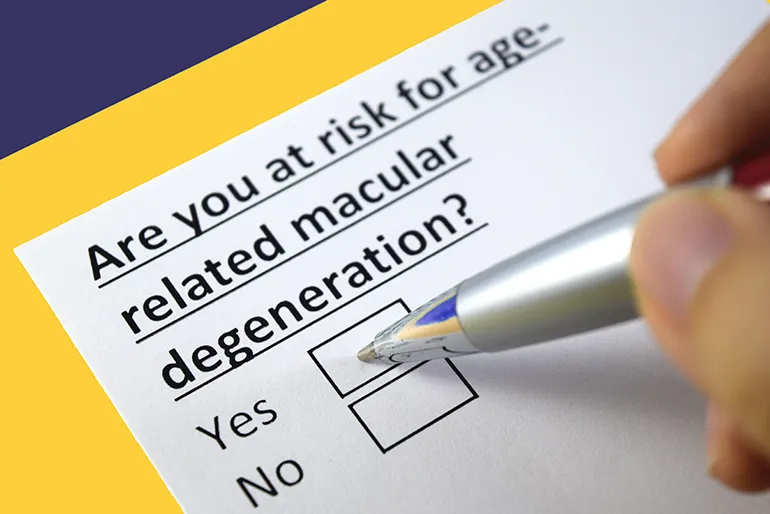
Age-related macular degeneration, or AMD, is a prevalent eye condition that commonly affects older adults. Like other parts of the body, our eyes experience gradual degeneration as we age. In AMD, this degeneration specifically impacts the macula—a small, vital area of the retina that plays a crucial role in providing sharp, central vision.
What is the Macula and Why Does it Matter?
Think of your eye as a camera, with the macula acting as the high-resolution center of the sensor—essential for sharp, detailed central vision needed for activities like reading, driving, recognizing faces, and observing fine details. When AMD occurs, this central vision begins to deteriorate, causing blurriness or even a blind spot in the middle of your field of view. This can significantly affect the ability to perform everyday tasks.
Types of AMD: Wet vs Dry AMD
There are two types of macular degeneration: dry (non-neovascular) and wet (neovascular). The dry form is the more common, accounting for around 85-90% of cases. In dry AMD, small yellow deposits called drusen accumulate under the retina, gradually breaking down cells in the macula. Vision loss tends to be gradual, and most people experience no symptoms in the early stages. The advanced form, known as geographic atrophy, is more prevalent among Caucasian populations compared to Asian populations.
Wet AMD, although less common, is more aggressive and can cause permanent blindness if not treated promptly. This form occurs when abnormal blood vessels grow beneath the retina, often leaking blood or fluid, leading to rapid and severe vision loss.
Am I at risk of AMD?
AMD primarily impacts individuals over the age of 50, with the risk escalating as one ages. Additional risk factors include:
- Genetics: A family history of AMD raises your likelihood of developing the condition.
- Smoking: This is one of the few modifiable risk factors; smoking significantly heightens the risk of AMD.
- Obesity: Carrying excess weight can also contribute to an increased risk of developing AMD.
Symptoms of AMD
In the early stages, AMD may not present any symptoms, making regular eye examinations essential. However, as the condition advances, you may start to notice:
- Blurred spots in your central vision
- Difficulty reading or recognizing faces
- Distorted vision, where straight lines appear wavy
- Colors that seem less vibrant
It’s important to assess your vision by checking each eye individually, as good vision in one eye can sometimes mask symptoms in the other.
Diagnosis and Detection
Early detection of AMD is crucial, which is why eye screenings are recommended, particularly for individuals over 50. Key screening tests include:
- Amsler Grid: A straightforward test where you observe a grid to check for wavy lines or missing sections.
- Dilated Fundus Examination: This allows for a detailed examination of the retina and macula.
- OCT (Optical Coherence Tomography): A scanning technique that provide cross-sectional images of the macula.
- Fluorescein Angiography: Primarily used to diagnose wet AMD, this test highlights abnormal blood vessels and any leakage.
Can AMD Be Treated or Prevented?
Dry AMD: While there is no specific treatment for dry AMD, certain vitamins, such as those found in AREDS2 formulations, may help slow its progression. In advanced stages of dry AMD, eye injections can assist in slowing the deterioration of central vision.
Wet AMD: Prompt and appropriate treatment with intravitreal anti-vascular endothelial growth factor (anti-VEGF) injections can effectively halt the growth of abnormal blood vessels, reduce fluid leakage, and prevent irreversible damage to the retina. A typical treatment plan involves three injections administered monthly, followed by maintenance injections at longer intervals to prevent recurrence.
Preventing Macular Degeneration
Healthy Diet: A diet rich in leafy greens, fish, nuts, and fruits is beneficial. Foods high in antioxidants and omega-3 fatty acids can support eye health.
Quit Smoking: This is one of the most significant lifestyle changes you can make to reduce the risk of AMD.
Exercise and Maintain a Healthy Weight: Regular physical activity and maintaining a healthy weight can contribute to overall eye health.
Protect Your Eyes: Wear sunglasses that block UV light to safeguard your eyes from harmful rays.
Managing AMD
Low vision aids, such as magnifiers and specialized glasses, can provide valuable assistance when living with macular degeneration. Additionally, modifying your home environment—like enhancing lighting or incorporating contrasting colors—can facilitate daily activities.
In conclusion, while AMD is a prevalent condition, it is manageable with awareness and proactive health measures. By recognizing its risks, symptoms, and the significance of regular eye screenings and timely treatment, we can all take meaningful steps to preserve our eyesight for as long as possible.












